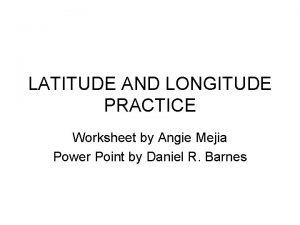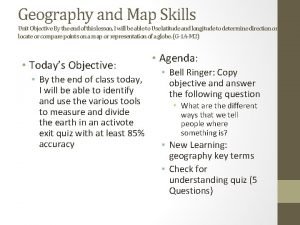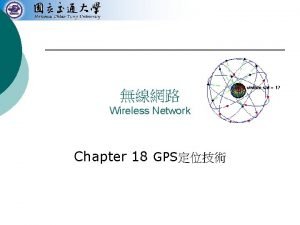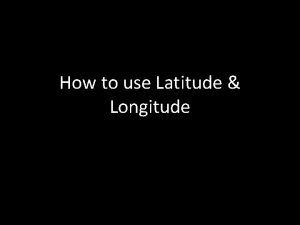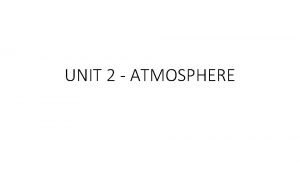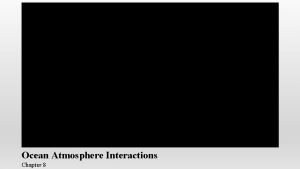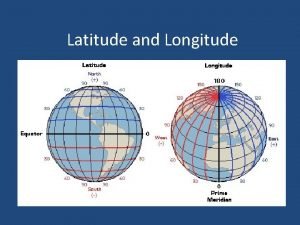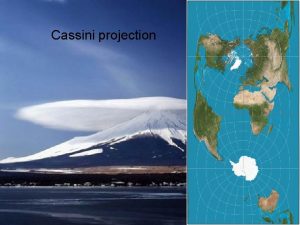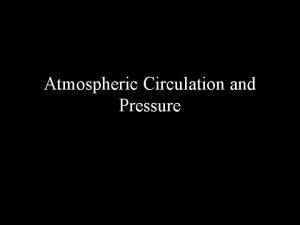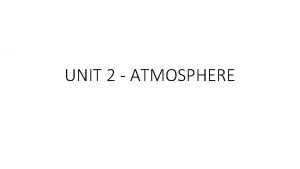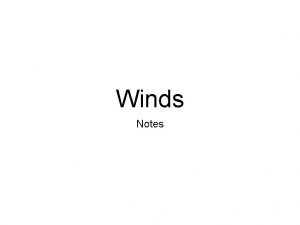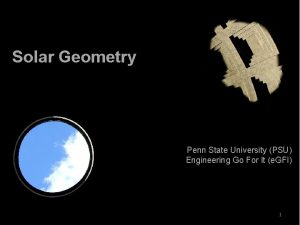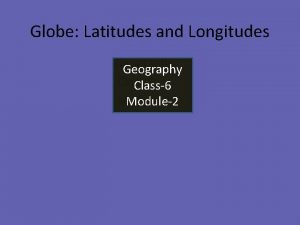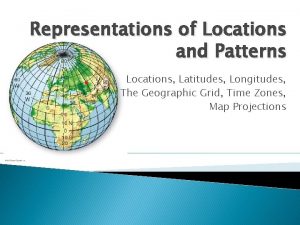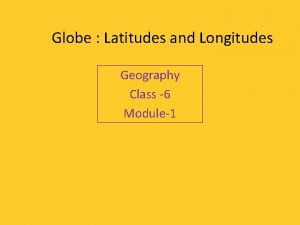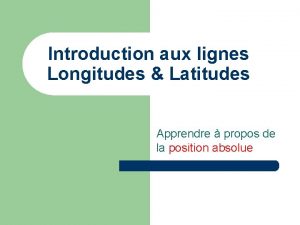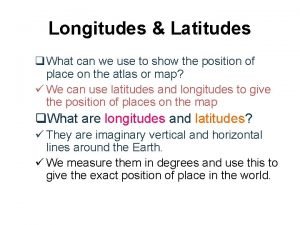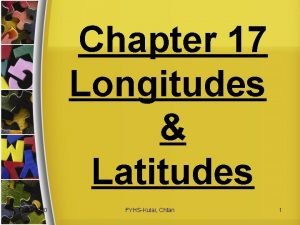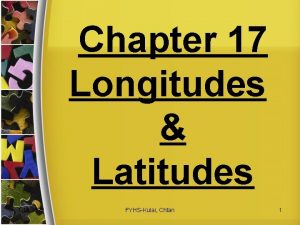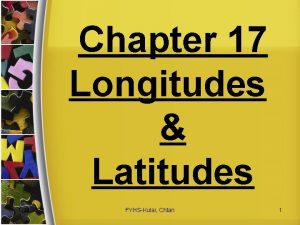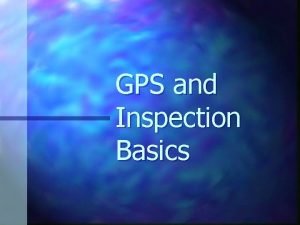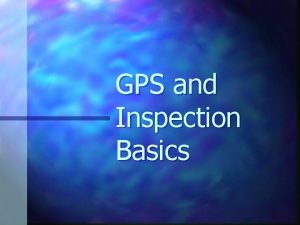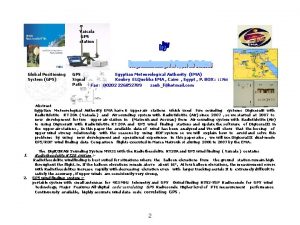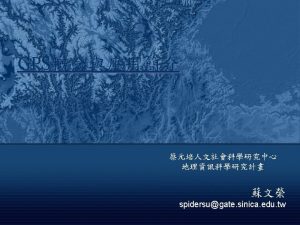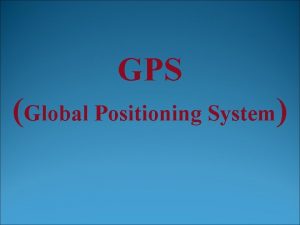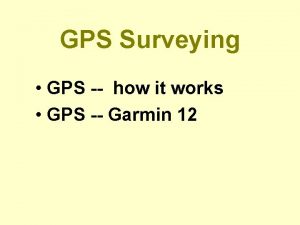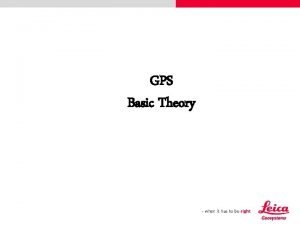Essentials of Navigation Latitudes Longitudes GPS and more



















- Slides: 19

Essentials of Navigation Latitudes & Longitudes, GPS, and more… For Race Officers and Mark Boat Operators From Sailwave Race Management Resources by Ed Bottrell ez. Trap Developer Halifax, Nova Scotia, CANADA A unique MS Excel© based system that helps sailboat Race Officers plan and manage racecourses anywhere in the world.

Topics � Latitude & Longitude � Degrees, minutes and seconds � Location on the globe � Mariner’s Compass � Headings and Bearings � Magnetic Compass � Variation and Deviation � Chart Compass Rose � Converting True-Magnetic- Compass readings using Variation and Deviation � Marine Charts � GPS � How GPS Works � Using GPS to set Race Marks Basic Navigation for ROs & Mark Boats Slide 2

Great Circles, Meridians and Longitude � Great circles � Line formed on the surface of the globe by the intersection of any plane thru center of the earth � Both halves of sphere are same size � Meridians or Lines of Longitude � Great Circles that also include North & South Poles � Prime Meridian (0° Longitude) runs through Greenwich, UK - Royal Observatory � A line of Longitude is measured in degrees, minutes and seconds (or in decimal minutes) from the Prime Meridian � 0 -180° East or West of Prime Meridian � Halifax, NS = about 63° 35’ Longitude (same line that runs just E of Bermuda, and between Argentina & Falkland Islands � Kandahar about 65° 42’ E Longitude � Eastern islands of Fiji are near 180° W, Western islands near 180° E Basic Navigation for ROs & Mark Boats Slide 3

Parallels of Latitude � Parallels of latitude � Small circles perpendicular to Equator � Equator is a great circle, perpendicular to Earth’s axis � Latitude is measured 0 -90° North or South of the Equator from the centre of the Earth � � Halifax 44° 38’ N Christchurch, NZ 43° 32’ S � 1’ Minute (arc) of Latitude = 1 Nautical Mile (nm) � 1 nm is about 15% longer than Statute Mile, = 6, 076 Feet, = 1, 852 M � 1 nm per hour = 1 knot (kt) � One unit of Latitude has the same length regardless of its location Basic Navigation for ROs & Mark Boats Slide 4

Degrees, Minutes and Seconds � Angular measures � 1° degree = 60’ minutes � 1’ minute = 60” seconds � Similar to Time: 1 hr=60 min � Decimals preferred for min. � Min. = Sec. /60: � 15” = 0. 25’ � 30” = 0. 50’ � 44° 38’ 12” N = 44° 38. 2’ N � Measuring Distance � One unit of Latitude has the same length regardless of its location � The same unit of Longitude has a variable length that reduces as the location moves N or S of the Equator Basic Navigation for ROs & Mark Boats Slide 5

Where are you? � Any point on Earth can be described by its Latitude and Longitude � Latitude: � 0 -90° N or S of equator � Marked on L & R sides of charts � 1’ Latitude = 1 nm � Longitude: � 0 -180° W or E of Prime Meridian � Marked on Top & Bottom of charts � Accuracy � ± 0. 1’ for chart work � GPS ± 0. 001’ � Charts – decimal minutes, no seconds Always use the Latitude scales (i. e. Left & Right side of charts) to measure distances. 1’ = 1 nm Basic Navigation for ROs & Mark Boats Slide 6

Mariner’s Compass � Circular scale 000° - 359°, clockwise � No decimals used � Can be absolute or relative � � E is 090° off starboard bow is relative � 3 -digits used for absolute (015° not 15°) � Some old references still used � � Prior to WWII North, NE, NNE, etc. 000° =N, 090°=E, 180°=S, 270°=W Today - do not say “steer NNE” (22. 5°), rather 022° or 023° � Directions usually taken from where you are, and absolute � Exception: Wind Direction is towards you (e. g. wind 225° = from the SW to you) � Exception: Relative Bearing (e. g. buoy 45° off port bow) Basic Navigation for ROs & Mark Boats 16 -point Compass Rose Slide 7

Headings and Bearings � Heading: where the bow is pointing � Course: the direction the boat is actually travelling (e. g. effects of leeway and/or current) � Bearing: the direction of an object as determined by a compass � Reciprocal (Heading, Bearing, Course, etc. ): opposite direction (180° difference) Basic Navigation for ROs & Mark Boats Slide 8

Magnetic Compass & Card � Ship’s Compass � Typically Binnacle or dash mounted � One moving part – card in transparent housing with damping fluid � Card aligns with Magnetic North – boat moves underneath � Built in magnets with adjustments to help alignment � Lubber’s Line parallel to centerline of boat � Affected by metal and magnetic fields on-board (Deviation) � Handheld Magnetic Compass � Card aligns with Magnetic North � No significant Deviation Basic Navigation for ROs & Mark Boats Slide 9

True vs. Magnetic North � Charts drawn relative to True North � North Pole 400+ miles from magnetic North Pole � A Magnetic Compass points to Magnetic North � W. of Ellesmere Island , Canada about Lat. 83° N Long. 114° W � Moving to NW towards Siberia (about 25 miles per year) � Difference is Variation or Magnetic Declination � Changes depending on your location: � 18°W at Halifax, NS, CA � 0° at Duluth, MN � 18°E at Vancouver, CA � 24°W at Cape Town, SA � 23°E at Wellington, NZ � Shown on charts – Compass Rose � A magnetic Compass is also affected by localized iron and magnetism � Deviation : Measured in degrees E or W � Caused by Engine, tools, tanks, hardware, � Deviation of installed ship’s compass � Unique for each vessel � Adjustments can minimize to 5 -10° max. � Varies by direction – Deviation Card � Hand-held Compass (no deviation assumed) speakers, electrical power https: //www. ngdc. noaa. gov/geomag/calculators/magcalc. shtml#declination Basic Navigation for ROs & Mark Boats Slide 10

Compass Rose (On a Chart) Variation shown as XXX° W or E, Year last measured moving at YY’ E or W per year 020° W 1995 (3’ E) is effectively 019° W in 2012 Basic Navigation for ROs & Mark Boats Slide 11

Converting True - Magnetic - Compass � Why bother? � Is 15 -25° difference material? � 20° over 5 nm is 1. 7 nm! � Variation Primarily a function of geography – relatively fixed � Deviation varies by HDG and by specific boat (± 5 ° not unusual) � When converting True to Magnetic, add W Variation � 270° T + 20° W = 290° M � Magnetic to Compass, add W Deviation � 290° M - 5° E = 285° C � TVMDC <--E + W--> � 100° T + 20° W = 120° M + 5° W = 125° C � Mnemonics � True Virgins Make Dull Company At Weddings: TVMDC+W � Can Dead Men Vote Twice At Elections: CDMVT+E Basic Navigation for ROs & Mark Boats TVMDC E+W Slide 12

Other Factors � Electronic Compasses (Fluxgate and GPS) � Deviation can be eliminated � Choice of Magnetic or True displays � Also good for creating or checking Deviation Card � Leeway and Windage (powerboats) � Sideways movement, away from wind � Can be measured with coastal navigation chart work, trailing a line � Counteracted by changing Course to Steer (into the wind) � Function of wind direction, intensity and boat characteristics � Current � Tidal currents will vary with cycle of tide (e. g. Ebb, Flow) � Other currents may be steady (e. g. rivers, Gulfstream) � Set (direction 000° -359°) and Drift (speed in kt) � � Sometimes shown on Charts Calculated by chart work Basic Navigation for ROs & Mark Boats Slide 13

Marine (Mercator) Charts � Little distortion, therefore true distances can be measured � 1’ Latitude = 1 nautical mile (nm) � 1 nm per hour is 1 knot (kt) � Always use the Left or Right scales (Latitude) to measure distances � Linear scales OK for measurement in local area � Chart scales vary from chart to chart � Insets always have a different scale Basic Navigation for ROs & Mark Boats Slide 14

Charts – Other Information � Adjoining or inset Charts info. � Compass Rose(s) show variation � Warnings � Reference tables � Feet-meters-Fathoms conversion � Tidal information � Distance scales � Chart #1 – Symbols & Abbrev. � Natural & Cultural Features � Landmarks, � Seabed � Rocks, Wrecks, Obstructions � Commercial Routes � Security and special areas � Lights, Buoys, Fog Signals, Radar, and other Navigational Aids Basic Navigation for ROs & Mark Boats Slide 15

Global Positioning by Satellite � Satellites & Ground Stations (not discussed) � Receivers GPS accuracy typically 2 -10 m Note: LORAN-C decommissioned in 2010 Basic Navigation for ROs & Mark Boats Slide 16

How GPS Works � Receivers � Various formats and sizes – fixed, handheld, embedded (e. g. smartphone) � GPS receivers have been miniaturized to just a few integrated circuits � Receives and analyzes signals from satellites (12 -20 possible) � Memory to record time, last position, setup, route information, etc. even when unit is powered off � GPS for PCs < $100 � Transfer of data � NMEA 0183 or 2000 � Serial, USB or Bluetooth Basic Navigation for ROs & Mark Boats Slide 17

How GPS Works � Receiver Signal Analysis � By signal matching, the receiver determines the distance from each a satellite � Uses some correction information transmitted by each satellite to refine this information – typically 4+ satellites to get accuracy within 10 -15 m � Improving Accuracy – Differential GPS � Uses signal from one or more “near-by” ground station to correct positions � Canadian & US Coast Guard supported Differential GPS uses local ground stations � WAAS – Wide Area Augmentation System is an American system that calculates corrections and then transmits them from 2 geostationary satellites � WAAS coverage is accurate in US and Southern Canada, less accurate on other regions of satellite coverage � Differential GPS improves accuracy to within 2 meters � The receiver uses the position determined, and user entered data about waypoints to generate navigation displays � Course steered is the result of receiving a number of positions to define travel over ground, including the effects of current and leeway � Course may not match your ships compass - GPS does not measure deviation � Speed determined using the position information collected and the GPS system clock Basic Navigation for ROs & Mark Boats Slide 18

Using GPS to Set Race Marks � Functional capabilities and user instructions will vary with GPS manufacturer and model � Ensure the GPS and VHF/Cell communications units have been properly and consistently set-up � � � Horizontal Datum Measurement units (e. g. knots, nm or metres) True or Magnetic directions, including offsets � Familiarize yourself with basic operations including: � � � Entering way points (e. g. Mark & Pin locations) Go To way point navigation Position or location display including satellite acquisition Moving between screen displays Alarms (e. g. proximity) Power on/off – manual and automatic � Getting to the Mark Location � Obtain Mark Latitude & Longitude, Range and Reciprocal Bearing from RO – double check. � Options: Enter as a new Way Point, then use Go To function. � RC Boat can be entered as a Way Point for checking � Sail the Latitude – navigate to the desired Latitude then turn and sail to the desired longitude keeping the latitude constant, or vice versa. � Double check the Reciprocal Bearing to the RC Boat with a compass and/or use a Go To function to see the distance and bearing (Reciprocal) to the RC Boat. � If visible, ask RC Boat for confirmation of Bearing to Mark � Make appropriate adjustments (e. g. upwind) for drift when dropping the anchor of the mark � Basic Navigation for ROs & Mark Boats Slide 19
 Lirik lagu more more more we praise you
Lirik lagu more more more we praise you More more more i want more more more more we praise you
More more more i want more more more more we praise you Worksheet c latitude and longitude the grid system
Worksheet c latitude and longitude the grid system Define latitude and longitude
Define latitude and longitude Gps gps gps
Gps gps gps Modulo positioning
Modulo positioning Instrumentos para medir longitudes
Instrumentos para medir longitudes The lines of longitudes run from_________ to________ pole.
The lines of longitudes run from_________ to________ pole. Easterlies and westerlies
Easterlies and westerlies Horse latitudes
Horse latitudes Why is it called horse latitudes
Why is it called horse latitudes Imaginary horizontal lines in the globe.
Imaginary horizontal lines in the globe. Lowest land point on earth
Lowest land point on earth Single cell model of atmospheric circulation
Single cell model of atmospheric circulation Hadley cell
Hadley cell Horse latitudes doldrums
Horse latitudes doldrums Elizabeth mulroney
Elizabeth mulroney Wind notes
Wind notes What are latitudes
What are latitudes Human history becomes more and more a race
Human history becomes more and more a race


